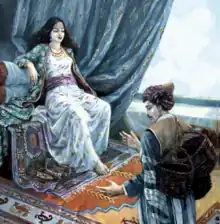Feqiyê Teyran (born Mir Mehemed, Kurdish: فەقیێ تەیران, romanized: Feqiyê Teyran, 1590–1660)[1] was a Kurdish poet who wrote in Kurmanji.[2] He is best known for his work Zembîlfiroş,[3] and is also credited for writing the first literary account of the Battle of Dimdim which took place in 1609 and 1610.[4] He is considered a pioneer in Kurdish Sufi literature and one of the founders of the Kurdish literary tradition with Ali Hariri, Melayê Cizîrî, Mela Huseynê Bateyî and Ehmedê Xanî.[5]
Biography
The first written information about Teyran stems from Mahmud Bayazidi in the mid-19th century. He was born in the village of Verezuz/Verezor, in Miks, Hakkâri of the Ottoman Empire and graduated from a madrasa. During his studies, he travelled to Hizan, Finik, Heşete and also to Cizre of Bohtan where he could have studied under Melayê Cizîrî. Instead of becoming a mullah, he continued to work on poetry as a profession and would wander around like a dervish and read his poems to the assemblies and madrasas he visited. His father was named Abdullah and Teyran plausibly came from a family of beys since he used the title mir. He died in Miks, but his tombstone was only found in 2013 in the village of Şandis in Hizan.[1][5]
Style and legacy
Poems of Teyran which have been described as 'colorful' have subsequently been used in Kurdish folk music.[6] He wrote in plain language, used folklore elements and drew attention to mysticism. Subjects included divine love, knowledge, wisdom, female beauty, nature and the waḥdat al-wujūd. His poems were written in prosody and he preferred quatrains over couplets.[5]
Works

- Hikâyetâ Şeyh-i San’ân (1621)[5]
- Kısseyâ Bersîs[5]
- Kavlê Hespê Reş[5]
- Dilo Rabê (1631)[5]
- Cezerî (1640, written to Melayê Cizîrî)[5]
- Zembîlfiroş
- Bersîsê Âbid
- Beyta Dimdim
References
- 1 2 Omarkhali, Khanna (2011). "Yezidi religious oral poetic literature: Status, formal characteristics and genre analysis". Scrinium. Brill Publishers: 155. doi:10.1163/18177565-90000247.
- ↑ Kreyenbroek, Philip G. (2005). "Kurdish written literature". Encyclopedia Iranica.
- ↑ "1 زەمبیلفرۆش كێیە و چۆن گەیشتە باتیفا". Wishe. November 1, 2016.
- ↑ Hassanpour, Amir (1995). "DIMDIM". Encyclopedia Iranica. VII.
- 1 2 3 4 5 6 7 8 Özel, Ahmet (2016). "FAKĪ-yi TEYRÂN". TDV İslâm Ansiklopedisi (in Turkish).
- ↑ Leezenberg, Michiel (2020). "Between Islamic Learning and Philological Nationalism: Mullah Mahmûdê Bayazîdî's Auto-ethnography of the Kurds". Die Welt des Islams. Brill Publishers. 6 (4): 433–472. doi:10.1163/15700607-00600A09. hdl:11245.1/a4ce3840-01e3-49d4-b822-e6b49849a5df.
Further reading
- Mohammad, Sheelan Y.; Mohammad, Abdi H. (2019). شرۆڤهكرنا چیرۆكه شیعرا "بهرصیصێ عابد" یا "فهقیێ تهیران" لدویڤ تیۆرا گریماسى (ئهركێ كریارێن كاراكتهران و ئهركێ زنجیرهیى) – خواندنهكا ڤهگێرانناسى یه- [Analysis of the epic "Bersisi Abed" for poet "Faqi Tayran" according to Grimas Theory]. Humanities Journal of University of Zakho (in Kurdish). 7 (3): 283–294. doi:10.26436/hjuoz.2019.7.3.513.